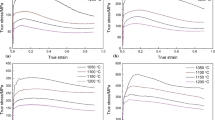Abstract
A very high-temperature reactor (VHTR) has been studied among generation IV nuclear power plants owing to its many advantages such as high-electric efficiency and massive hydrogen production. The material used for the heat exchanger should sustain structural integrity for its life even though the material is exposed to a harsh environment at 1223 K (950 °C) in an impure helium coolant. Therefore, an enhancement of the material performance at high temperature gives a margin in determining the operating temperature and life time. This work is an effort to find an optimum combination of alloying elements and processing parameters to improve the material performance. The tensile property and microstructure for nickel-based alloys fabricated in a laboratory were evaluated as a function of the heat treatment, cold working, and grain boundary strengthener using a tension test at 1223 K (950 °C), scanning electron microscopy, and transmission electron microscopy. Elongation to rupture was increased by additional heat treatment and cold working, followed by additional heat treatment in the temperature range from 1293 K to 1383 K (1020 °C to 1110 °C) implying that the intergranular carbide contributes to grain boundary strengthening. The temperature at which the grain boundary is improved by carbide decoration was higher for a cold-worked specimen, which was described by the difference in carbide stability and carbide formation kinetics between no cold-worked and cold-worked specimens. Zr and Hf played a scavenging effect of harmful elements causing an increase in ductility.















Similar content being viewed by others
References
C. Cabet and F. Rouillard: J. Nuclear Materials, 2009, vol. 392, pp. 235-242.
K.G.E. Brenner and L.W. Graham: Nucl. Technol. 1984, vol. 66, pp. 404-414.
D.-J. Kim, G.-G. Lee, S. J. Jeong, W. G. Kim and J. Y. Park: Nucl. Eng. Tech. 2011, vol. 43, pp. 429-436.
G.-G. Lee, S.-J. Jung, D. Kim, Y.-H. Jeong and D.-J. Kim: Kor. J. Met. Mater. 2012, vol. 50, pp. 659-667.
R.C. Reed: The Superalloys Fundamentals and Applications, Cambridge University Press, New York, 2006, p. 85.
Q. Wu, H. Song, R. W. Swindeman, J. P. Shingledecker and V. K. Vasudevan: Metall. Mater. Trans. A, 2008, vol. 39, pp. 2569-2585.
W. Ren and R. Swimdeman: J. Pressure Vessel Technol. 2009, vol. 131, pp. 024002-1-024002-15.
L. Tan, K. Sridharan, T. R. Allen, R. K. Nanstad and D. A. McClintock: J. Nuclear Materials, 2008, vol. 74, pp. 270-280.
L. Jiang, R. Hu, H. Kou, J. Li, G. Bai and H. Fu: Materials Science and Eng. A, 2012, vol. 536, pp. 37-44.
ASTM Standard Test Methods: ASTM E8, 2002.
Y. S. Lim, J. H. Suh, I. H. Kuk and J. S. Kim: Metall. Mater. Trans. A, 1997, vol. 28, pp. 1223-1231.
P. Shi and B. Sundman: TCC TM Thermo-Calc® Software User’s Guide, Ver. S, Foundation of Computational Thermodynamics Stockholm, Sweden, 2008.
M.J. Donachie and S.J. Donachie: Superalloys A Technical Guide, 2nd ed., ASM International, Materials Park, OH, 2002, p. 224.
S. Kihara, J. B. Newkirk, A. Ohtomo and Y. Saiga: Metall. Trans. A, 1980, vol. 11, pp. 1019-1031.
G.D. Smith, C.S. Tassen, P. Ganesan, and J.M. Wheeler: US Patent 4,877,461, 1989.
S. Schlegel, S. Hopkins, E. Young, J. Cole, T. Lillo and M. Frary: Metall. Mater. Trans. A, 2009, vol. 40, pp. 2812-2823.
C.R. Barrett, W.D. Nix and A.S. Tetelman: The Principles of Engineering Materials, Prentice-Hall, Inc., Englewood Cliffs, NJ, 1973, p. 166.
D.-J. Kim, G.-G. Lee, D. Kim and S. J. Jeong: J. Mater. Sci. Technol. 2013, vol. 29, pp. 1184-1190.
Acknowledgments
This work was carried out as a part of the Nuclear R&D Program financially supported by the Ministry of Science, ICT and Future Planning (MSIP) of Korea.
Author information
Authors and Affiliations
Corresponding author
Additional information
Manuscript submitted April 4, 2013.
Rights and permissions
About this article
Cite this article
Kim, DJ., Jung, S.J., Mun, B.H. et al. Parametric Study on the Tensile Properties of Ni-Based Alloy for a VHTR. Metall Mater Trans A 46, 47–57 (2015). https://doi.org/10.1007/s11661-014-2357-3
Published:
Issue Date:
DOI: https://doi.org/10.1007/s11661-014-2357-3




